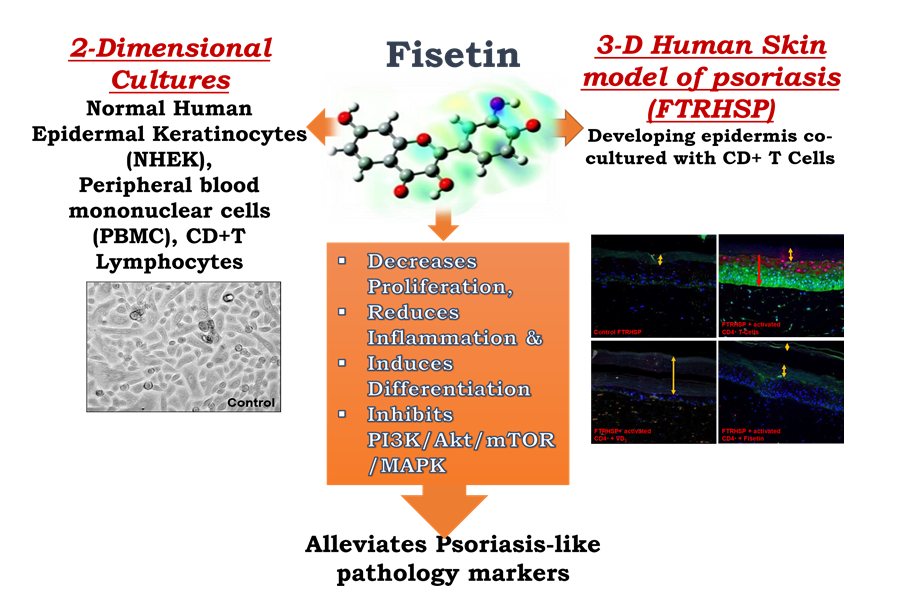Preprint
Article
Fisetin a 3, 7, 3′, 4′-Tetrahydroxyflavone Inhibits PI3K/Akt/mTOR and MAPK Pathways and Ameliorates Psoriasis Pathology in 2D and 3D Organotypic Human Inflammatory Skin Models
Altmetrics
Downloads
516
Views
504
Comments
0
A peer-reviewed article of this preprint also exists.
supplementary.pdf (272.49KB )
This version is not peer-reviewed
Submitted:
07 September 2019
Posted:
09 September 2019
You are already at the latest version
Alerts
Abstract
Psoriasis is a chronic immune-mediated skin disease that involves interaction of both immune and skin cells, and is characterized by cytokine-driven epidermal hyperplasia, deviant differentiation, inflammation and angiogenesis. Because available treatments for psoriasis have significant limitations, dietary products are potential natural sources of therapeutic molecules, which can rescind molecular defects associated with psoriasis and could be developed for its management. Fisetin (3,7,3′,4′- tetrahydroxyflavone), a phytochemical naturally found in pigmented fruits and vegetables has demonstrated pro-apoptotic and antioxidant effects in several malignancies. This study utilized biochemical, cellular, pharmacological and tissue-engineering tools to characterize the effects of fisetin on normal human epidermal keratinocytes (NHEKs), peripheral blood mononuclear cells (PBMC) and CD4+ T lymphocytes in 2D and 3D psoriasis-like disease models. Fisetin treatment of NHEKs dose and time-dependently induced differentiation and inhibited interleukin-22-induced proliferation, as well as activation of the PI3K/Akt/mTOR pathway. Fisetin treatment of TNF-α-stimulated NHEKs significantly inhibited the activation of p38 and JNK, but had no effect on ERK1/2. In addition, fisetin treatment significantly decreased the secretion of Th1/Th-17 pro-inflammatory cytokines, particularly IFNγ and IL-17A by 12-O- tetradecanolylphorbol 13-acetate (TPA)-stimulated NHEKs and anti-CD3/CD28-activated human PBMCs. Furthermore, we established the in-vivo relevance of fisetin functions, using a 3D full-thickness human skin model of psoriasis (FTRHSP) that closely mimics in-vivo human psoriatic skin-lesions. Herein, fisetin significantly ameliorated psoriasis-like disease features, and decreased the production of IL-17 by CD4+ T lymphocytes co-cultured with FTRHSP. Collectively, our data identify pro-differentiative, anti-proliferative and anti-inflammatory effects of fisetin, via modulation of PI3K-Akt-mTOR and p38/JNK pathways and the production of cytokines in 2D and 3D human skin model of psoriasis. These results suggest that fisetin has a great potential to be developed as an effective and inexpensive agent for the treatment of psoriasis and other related inflammatory skin disorders.

Keywords:
Subject: Medicine and Pharmacology - Dermatology
Copyright: This open access article is published under a Creative Commons CC BY 4.0 license, which permit the free download, distribution, and reuse, provided that the author and preprint are cited in any reuse.
MDPI Initiatives
Important Links
© 2024 MDPI (Basel, Switzerland) unless otherwise stated








